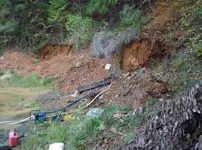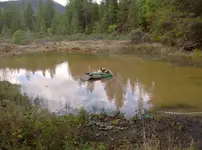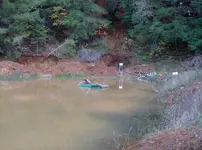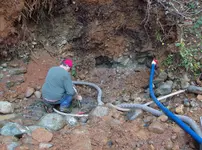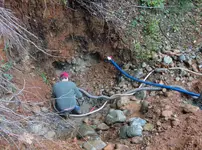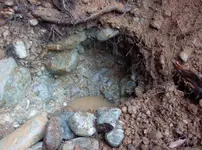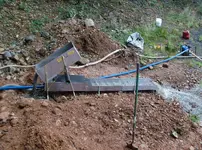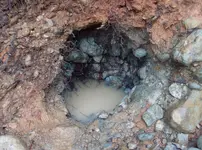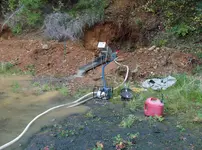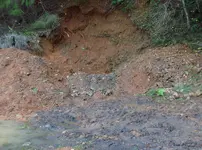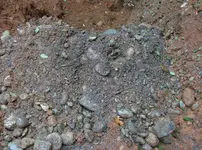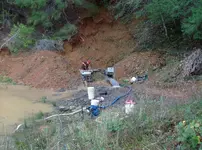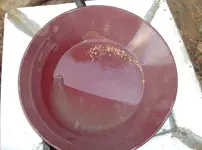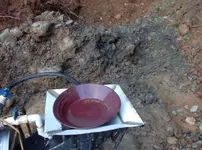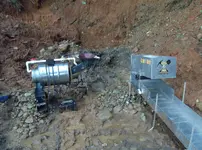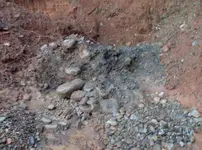You are using an out of date browser. It may not display this or other websites correctly.
You should upgrade or use an alternative browser.
You should upgrade or use an alternative browser.
Early year rains have given an opportunity for early in the year work start
- Thread starter M.E.G.
- Start date
- Joined
- Jan 1, 2013
- Messages
- 2,663
- Reaction score
- 5,459
- Golden Thread
- 0
- Detector(s) used
- Tesoro Vaquero, Whites MXT, Vsat, GMT, 5900Di Pro, Minelab GPX 5000, GPXtreme, 2200SD, Excalibur 1000!
- Primary Interest:
- All Treasure Hunting
Do you pull the belt off of the Gast when you're not using it?
delnorter
Hero Member
- Joined
- Oct 28, 2008
- Messages
- 912
- Reaction score
- 2,325
- Golden Thread
- 0
- Location
- Northern California
- Primary Interest:
- All Treasure Hunting
Nice looking bank material MEG. Are you hydraulicing with the blue hose?
Mike
Mike
M.E.G.
Hero Member
- Joined
- Apr 25, 2014
- Messages
- 502
- Reaction score
- 880
- Golden Thread
- 0
- Primary Interest:
- All Treasure Hunting
- #5
Thread Owner
Nice looking bank material MEG. Are you hydraulicing with the blue hose?
Mike
The co-owner and I think so too. For the little bit of work in the pictured working area, it shows O.K. color so far. And yes, "hydraulicing" At that time it was just for testing the compaction of the material. As can be seen by the pics, the material is well compacted in the one pic, but not so much just feet away. Will be digging in with a hyraulic shovel soon.
M.E.G.
Hero Member
- Joined
- Apr 25, 2014
- Messages
- 502
- Reaction score
- 880
- Golden Thread
- 0
- Primary Interest:
- All Treasure Hunting
- #6
Thread Owner
As can be seen by the first and third pic, there is about 8 feet of old channel gravels exposed to work, but in order to work them safely the dirt above (somewhere between 20 and 30 feet) has got to be move away. Just the little work done was bringing small amounts of dirt down on us.
ClaimStake
Full Member
- Joined
- Jul 27, 2015
- Messages
- 198
- Reaction score
- 233
- Golden Thread
- 0
- Location
- Oroville CA
- Detector(s) used
- Gold Bug 2 (sold it)
- Primary Interest:
- Prospecting
that pond is a depression. a subduction point.
valley on one side, hill on the other, gold in between the pond and hill.
I know of many places like this. sometimes there's gold sometime there isn't.
nice spot keep digging.
are there anymore ponds like that nearby?
what state are you in.
valley on one side, hill on the other, gold in between the pond and hill.
I know of many places like this. sometimes there's gold sometime there isn't.
nice spot keep digging.
are there anymore ponds like that nearby?
what state are you in.
Last edited:
M.E.G.
Hero Member
- Joined
- Apr 25, 2014
- Messages
- 502
- Reaction score
- 880
- Golden Thread
- 0
- Primary Interest:
- All Treasure Hunting
- #8
Thread Owner
Pics of some of gold found prior around this water body can been seen at these links:
http://www.treasurenet.com/forums/g...-little-after-christmas-gold.html#post4322272
The pics in this below link are of the same spot being worked in pics on this thread, earlier in the year as the old channel material was being uncovered.
http://www.treasurenet.com/forums/gold-prospecting/504669-after-6-pans-cons.html
http://www.treasurenet.com/forums/g...-little-after-christmas-gold.html#post4322272
The pics in this below link are of the same spot being worked in pics on this thread, earlier in the year as the old channel material was being uncovered.
http://www.treasurenet.com/forums/gold-prospecting/504669-after-6-pans-cons.html
Last edited:
M.E.G.
Hero Member
- Joined
- Apr 25, 2014
- Messages
- 502
- Reaction score
- 880
- Golden Thread
- 0
- Primary Interest:
- All Treasure Hunting
- #9
Thread Owner
This property is an old (late 1800s, early 1900s) hydrauliced area. I have found only one historicl picture of the workings at the time. History has it, water was brought to this location from miles around. There was about five acres of soil (red dirt clay), 20 to 30 feet in depth, washed from this location just to reach the old channel gravels.
ClaimStake
Full Member
- Joined
- Jul 27, 2015
- Messages
- 198
- Reaction score
- 233
- Golden Thread
- 0
- Location
- Oroville CA
- Detector(s) used
- Gold Bug 2 (sold it)
- Primary Interest:
- Prospecting
if that's the case than that pond was never a pond. it was a small meadow turned into one.
delnorter
Hero Member
- Joined
- Oct 28, 2008
- Messages
- 912
- Reaction score
- 2,325
- Golden Thread
- 0
- Location
- Northern California
- Primary Interest:
- All Treasure Hunting
Over long periods of time, I believe ponds become meadows.
Mike
Mike
Goldwasher
Gold Member
- Joined
- May 26, 2009
- Messages
- 6,084
- Reaction score
- 13,254
- Golden Thread
- 1
- Location
- Sailor Flat, Ca.
- 🥇 Banner finds
- 1
- Detector(s) used
- SDC2300, Gold Bug 2 Burlap, fish oil, .35 gallons of water per minute.
- Primary Interest:
- All Treasure Hunting
recent geology is out the window when your working old diggins'. I see nothing that shows anything about meadows or valleys. Just the head of an old pit where the old timers left off. Looks like they've worked down about twenty feet from where their boots were first on the ground.
.
.
wildminer
Hero Member
- Joined
- Dec 2, 2015
- Messages
- 611
- Reaction score
- 901
- Golden Thread
- 0
- Location
- Jefferson Coast
- Primary Interest:
- Prospecting
Good job MEG and thanks for posting. Got my juices going, but the zone I want to get back to has got too much water. ha
ClaimStake
Full Member
- Joined
- Jul 27, 2015
- Messages
- 198
- Reaction score
- 233
- Golden Thread
- 0
- Location
- Oroville CA
- Detector(s) used
- Gold Bug 2 (sold it)
- Primary Interest:
- Prospecting
often times the old timers would use meadows pre existing ponds and other hard ground to hold the water.
also the grounds structural properties will remain the same as you dig down until you hit the next strata layer.
that whole area is an old volcano. the pond is where the ground implodes as the surrounding terrain explodes. this has the effect of concentrating the heavy materials into the high pressure points while ejecting the lighter materials into any voids(air) or low pressure areas.
just because you see cobbles or gravel doesn't mean it was worn by water. heat will do the same thing. things tend to spin around a lot in a volcanic eruption.
also here's some logic most people never seem to think about.
if a mountain erodes faster than it builds than it can not build.
in many places the ground is actually being pulled uphill. lites will erode faster than heavies.
and also lites accelerate and decelerate faster than heavies.
water flow has "absolutely" nothing to do with how the terrain gets shaped. the movement of the terrain determines the position of the creeks, rivers and washes.
not the other way around.
so if you think you're mining an ancient creek bed high and dry. chances are it's the bed of the creek nearby that got pulled up the hill.
if you find a nice pocket on the side of a hill with a lead traveling down. it's likely traveling up to that point and getting held up at a hard point in the terrain.
i'm currently working on a new theory in geology. our current understanding of the mechanical motion of the terrain is extremely lacking.
I don't want to highjack MEG's thread with this though.
and i'm still trying to get it all together right to really explain it in a simple way without going over people's heads too much.
has a lot to do with how volumes of materials kinetically/mechanically structure while moving and deforming.
a lot of fractal geometry and mechanics. it gets into it. and it works beautifully.
also the grounds structural properties will remain the same as you dig down until you hit the next strata layer.
that whole area is an old volcano. the pond is where the ground implodes as the surrounding terrain explodes. this has the effect of concentrating the heavy materials into the high pressure points while ejecting the lighter materials into any voids(air) or low pressure areas.
just because you see cobbles or gravel doesn't mean it was worn by water. heat will do the same thing. things tend to spin around a lot in a volcanic eruption.
also here's some logic most people never seem to think about.
if a mountain erodes faster than it builds than it can not build.
in many places the ground is actually being pulled uphill. lites will erode faster than heavies.
and also lites accelerate and decelerate faster than heavies.
water flow has "absolutely" nothing to do with how the terrain gets shaped. the movement of the terrain determines the position of the creeks, rivers and washes.
not the other way around.
so if you think you're mining an ancient creek bed high and dry. chances are it's the bed of the creek nearby that got pulled up the hill.
if you find a nice pocket on the side of a hill with a lead traveling down. it's likely traveling up to that point and getting held up at a hard point in the terrain.
i'm currently working on a new theory in geology. our current understanding of the mechanical motion of the terrain is extremely lacking.
I don't want to highjack MEG's thread with this though.
and i'm still trying to get it all together right to really explain it in a simple way without going over people's heads too much.
has a lot to do with how volumes of materials kinetically/mechanically structure while moving and deforming.
a lot of fractal geometry and mechanics. it gets into it. and it works beautifully.
M.E.G.
Hero Member
- Joined
- Apr 25, 2014
- Messages
- 502
- Reaction score
- 880
- Golden Thread
- 0
- Primary Interest:
- All Treasure Hunting
- #15
Thread Owner
Got to put some work toward exposing the old channel gravels before the rain started. It turns out they are a lot thicker than originaly thought, 16+ feet expose so far.
Hill side slid down trapping the bucket. It's an old machine, little under powered, so it took some work to got er free.
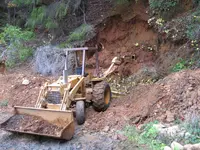
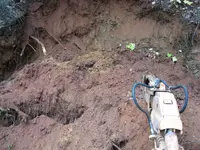
Dug out some hard pac:
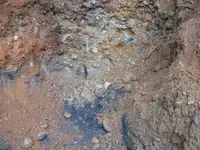
Pile of old channel material ready for processing:

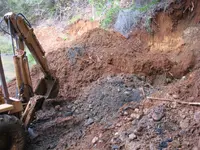
Old channel gravels exposed 16+ feet up:
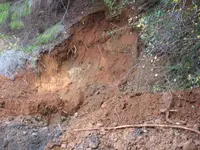
Hill side slid down trapping the bucket. It's an old machine, little under powered, so it took some work to got er free.


Dug out some hard pac:

Pile of old channel material ready for processing:


Old channel gravels exposed 16+ feet up:

Last edited:
Jeff95531
Silver Member
- Joined
- Feb 10, 2013
- Messages
- 2,625
- Reaction score
- 4,094
- Golden Thread
- 0
- Detector(s) used
- Teknetics Alpha 2000
- Primary Interest:
- Prospecting
Is that the blue clay I've been studying about Now that I look closer...a mineral? I've yet to find it in my parts but it's a good time of year to go high mountain prospecting.
Now that I look closer...a mineral? I've yet to find it in my parts but it's a good time of year to go high mountain prospecting.
 Now that I look closer...a mineral? I've yet to find it in my parts but it's a good time of year to go high mountain prospecting.
Now that I look closer...a mineral? I've yet to find it in my parts but it's a good time of year to go high mountain prospecting.
Last edited:
ClaimStake
Full Member
- Joined
- Jul 27, 2015
- Messages
- 198
- Reaction score
- 233
- Golden Thread
- 0
- Location
- Oroville CA
- Detector(s) used
- Gold Bug 2 (sold it)
- Primary Interest:
- Prospecting
this video shows a similar type of deposit.
Goldwasher
Gold Member
- Joined
- May 26, 2009
- Messages
- 6,084
- Reaction score
- 13,254
- Golden Thread
- 1
- Location
- Sailor Flat, Ca.
- 🥇 Banner finds
- 1
- Detector(s) used
- SDC2300, Gold Bug 2 Burlap, fish oil, .35 gallons of water per minute.
- Primary Interest:
- All Treasure Hunting
Austrailian residual deposit vs ancient alluvial gravel in Oregon. Thy are notably different. The Aussie video shows text book https://en.wikipedia.org/wiki/Eluvium . Meg Isn't showing his pile but, I'd put money on it that visually the gold looks quite different. Considering it is coming from an ancient alluvial gravel channel in Oregon. That happens to be part of a well known and significantly worked and studied region consisting of much of the same types of channels.
The volcanism and uplift occurring in the western U.S. and the different times that gravels were deposited are markedly different than the historic geology that has occurred in the Austrailian gold fields. There are similar deposits in the U.S. but, not the one shown in Megs video.
I bet when meg gets closer to bedrock he will actually be able to figure the direction those gravels were flowing by the way they are laid out "shingling". That is if he doesn't know already.(from existing reports and maps that exist) water has pretty much everything to do with it.
The volcanism and uplift occurring in the western U.S. and the different times that gravels were deposited are markedly different than the historic geology that has occurred in the Austrailian gold fields. There are similar deposits in the U.S. but, not the one shown in Megs video.
I bet when meg gets closer to bedrock he will actually be able to figure the direction those gravels were flowing by the way they are laid out "shingling". That is if he doesn't know already.(from existing reports and maps that exist) water has pretty much everything to do with it.
Goldwasher
Gold Member
- Joined
- May 26, 2009
- Messages
- 6,084
- Reaction score
- 13,254
- Golden Thread
- 1
- Location
- Sailor Flat, Ca.
- 🥇 Banner finds
- 1
- Detector(s) used
- SDC2300, Gold Bug 2 Burlap, fish oil, .35 gallons of water per minute.
- Primary Interest:
- All Treasure Hunting
heres a great site. Alluvial placer deposits, geology, exploration, mining, use - Page V
Similar threads
- Replies
- 12
- Views
- 359
- Replies
- 14
- Views
- 1K
- Suggestion
- Replies
- 6
- Views
- 801
Users who are viewing this thread
Total: 1 (members: 0, guests: 1)
Latest Discussions
-
-
-
-
Axe and Celt found in close proximity the same day
- Latest: Tesorodeoro

